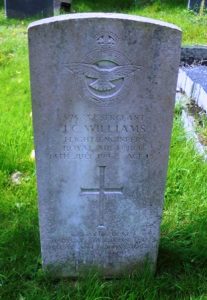Llanwnog, or Llanwnnog, is a village in Montgomeryshire, situated one-and-a half miles north of Caersws, on the B4568 road, just off the A489 road between Caersws and Carno. The Cambrian Railway ran through the village. Within the village lies the parish church, which is dedicated to St. Gwynog. The parishioners of the church who fell during both World Wars are commemorated on the parish war memorial, which is situated in the churchyard. The memorial takes the form of a Celtic cross. Affixed to the base is a cast bronze plaque, which contains the names of the parishioners killed during both World Wars. The photograph of the memorial is courtesy of Gethin Matthews.
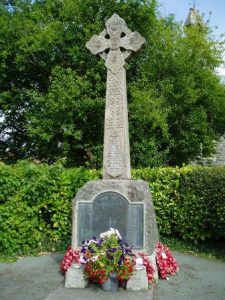
The Great War, 1914-1918
Andrew Breese, Gunner, 711652, Royal Field Artillery. Andrew was the son of Richard and Elizabeth Breese, of Llanwnog. He married Elizabeth Corfield in 1910 and the couple initially lived with her parents, whilst Andrew worked as a boot repairer in Newtown. Andrew enlisted into the Royal Field Artillery and was posted to ‘B’ Battery, 87th Brigade, Royal Field Artillery, which was attached to the 19th (Western) Division. The Division had embarked for France in July 1915 and had taken part in almost every major offensive, thereafter, seeing its first action during the Battle of Loos. In 1916 the Division saw heavy fighting during the Somme offensive, then in 1917 took part in the Battle of Messines Ridge and in the Third Battle of Ypres. The Division was caught up in the heavy fighting which followed the launching of the German Spring offensive on the Somme on 21 March 1918, then moved to the Messines area to rebuild, where it was caught up in the second phase of the German offensive on 9 April. The battered Division was then transferred south to the Aisne, but on 27 May was caught up in the third, and final, German offensive of 1918, and suffered terribly yet again. The Division was vastly rebuilt before returning to action later in the summer of 1918, taking part in the great offensive which ultimately forced the German surrender. Andrew survived the war but took ill just after the Armistice, and died of disease, probably influenza, at Etretat on 25 November 1918. The 37-year-old is buried in Etretat Churchyard Extension, France.
Alfred Collins, Private, 1094, Royal Welsh Fusiliers. Alfred was born at Bridge End, Llandinam in 1892, the son of Richard and Mary Collins. His father worked as a railway labourer, and by 1911 the family had moved to Long Length, Caersws, where Alfred worked as a wheelwright. Alfred enlisted at Newtown into the 1/7th Battalion, Royal Welsh Fusiliers soon after the outbreak of war. The battalion was a Territorial unit, which mobilised for war at Newtown in August 1914, as part of North Wales Brigade, Welsh Division and moved to Conway until the end of the month, before moving to Northampton. In December the Division moved to Cambridge and then in May 1915 to Bedford, where the Division was numbered and the formation became 158 Brigade, 53rd (Welsh) Division. On 19 July 1915 the entire Division sailed from Devonport for Imbros and on 9 August 1915 landed at Suvla Bay. The infantry moved off the beaches into the bush, but due to a lack of maps and no knowledge of the terrain, many of the units became disorientated, and the situation became chaotic. Alfred was killed in action on the following day, 10 August 1915. The 23-year-old has no known grave and is commemorated on the Helles Memorial, Gallipoli. Alfred is not commemorated on the Llandinam war memorial.
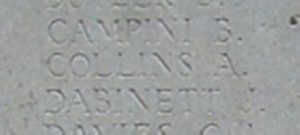
John Davies, Private, 55393, Royal Welsh Fusiliers. John was the son of David and Elizabeth Davies, of Llwydcoed, Llanwnog, Caersws. He enlisted at Newtown into the Royal Welsh Fusiliers and was drafted to France in the summer of 1916-17, joining the 19th Battalion, Royal Welsh Fusiliers. The battalion was attached to 119 Brigade, 40th (Bantam) Division and had been on the Western Front since June 1916. Late in 1916 the Division moved south to the Somme, and fought at the Battle of the Ancre, before remaining in the sector over the winter. In March 1917 the Germans withdrew to their shortened line, called the Hindenburg Line, and the 40th Division was among the units which followed the withdrawal. Later in the year the Division took part in the Battle of Cambrai and launched an attack on Bourlon Wood on 23 November 1917. The attack was carried out by 119 Brigade, led by the 12th SWB and 19th RWF. The 17th Welsh was in support for the initial assault, but was soon ordered to advance, to support the two attacking battalions. Heavy fighting raged within the wood over the coming days, with the 18th Welsh also being thrown forwards into the fight, and the Division suffered terribly. John was wounded during the fighting for Bourlon Wood and was evacuated to a nearby Casualty Clearing Station where he died of his wounds on 26 November 1917. The 22-year-old is buried in Rocquigny-Equancourt Road British Cemetery, Manancourt, France.
Hugh Evans, Private, 55201, Royal Welsh Fusiliers. Hugh was the son of Richard and Elizabeth Evans, of Cerrigybrain, Caersws. He enlisted at Welshpool into the Montgomeryshire Yeomanry, but in the winter of 1916-17 was drafted to France, joining the 2nd Battalion, Royal Welsh Fusiliers, which was on the Somme attached to 19 Brigade, 33rd Division. During the coming weeks the 2nd RWF received several drafts of reinforcements, and on 8 December the now fully rebuilt battalion moved to new positions at Suzanne, between Bapaume and Péronne. The Division remained in this sector over the coming months, before being transferred to the Arras sector, and reached Henin by 13 April, before the Division took over a section of front line facing the Hindenburg Line. The infantry battalions of the division then began the usual routines of rotating between the front-line, support and reserve trenches and the 2nd RWF took over a position known as Tunnel Trench. On 23 April the 2nd RWF took part in a costly assault on the Hindenburg Line, suffering heavy casualties. The battered battalion then moved to a rest camp at Basseux to rebuild, and by 15 May moved back into the line in the Croisilles Sector. The Division then carried out several assaults against the Hindenburg Line. On 22 April the 2nd RWF moved into the front line, to support the 1/4th Suffolk’s in another assault on the Hindenburg Line. The Suffolk’s launched their assault on the following morning, 24 April 1917 but became held up some 200 yards short of their objectives. C Company of the 2nd RWF followed the assault and began bombing their way forwards. Hugh was killed in action during the ferocious fighting that day. The 23-year-old is buried in Wancourt British Cemetery, France.
Richard Evans, Gunner, 134830, Royal Garrison Artillery. Richard was born in Machynlleth, the son of Richard and Ann Evans. By 1901 the family was residing at Brooklyn, Caersws. Richard enlisted at East Finchley, Middlesex into the Royal Garrison Artillery soon after the outbreak of war and was posted to the 265th Siege Battery, Royal Garrison Artillery. The battery embarked for France in February 1917 and moved into the Ypres Salient soon afterwards. The battery would have taken part in the softening up of the German positions for the offensive at Messines Ridge on 7 June and then in the main Passchendaele offensive which was launched on 31 July 1917. Richard was badly wounded during the Battle of Passchendaele and died of his wounds in the Casualty Clearing Station at Remi Sidings on 19 September 1917. The 25-year-old is buried in Lijssenthoek Military Cemetery, Belgium.
William Henry Fox, Private, 88426, The King’s (Liverpool Regiment). William was the son of Thomas Fox and Martha Ann Fox (nee Owen), of Penybont, Llangyniew. He married Margaret Delia Rowlands at Carno in 1916. William enlisted into the army after this and was initially posted to the East Surrey Regiment. After embarking for France in the winter of 1917, he initially joined the 2/7th Battalion, King’s (Liverpool Regiment), but was then posted to the 4th Battalion, King’s (Liverpool Regiment), which was attached to 98 Brigade, 33rd Division. William probably joined up with the battalion while it was in the Passchendaele Sector, following the closure of the Third Battle of Ypres. On 12 December the battalion was relieved and entrained at St. Jean for Eecke with the 33rd Division, to rest and rebuild. In January 1918 the battalion moved back into the line at Passchendaele, spending the coming weeks rotating between spells in the front line, and spells in reserve, and also supplying working parties. To the south, of 21 March 1918 the Germans launched the first phase of their Spring Offensive, along the section of front running from Croisilles to La Fère. On 9 April they launched the second phase of their offensive along the Lys valley and broke through the Allied lines. The 4th Kings were training behind the lines at Ambrines when the offensive was launched, and on 10 April was moved by train to Strazeele, to shore up the Allied line, taking up positions at Kemmel and Dranoutre, before advancing to Meteren where the battalion came into contact with the Germans on 15 April, beginning a period of desperate fighting over the coming days until the survivors were relieved on 19 April. On 21 April the survivors of the 33rd Division were inspected at Bavinchove by the grateful French Prime Minister, Clemenceau. The Division moved back into the line in the Dickebusch Lake and Ridge Wood sector on 4 May, and on 8 May the division became the target of a massive German artillery and gas bombardment, suffering heavy casualties before launching a counterattack on the east side of the lake. William was killed in action during the attack on 9 May 1918. The 23-year-old is buried in Klein-Vierstraat British Cemetery, Belgium.
Edward Watkin Francis, Private, 37196, Royal Welsh Fusiliers. Edward was the son of Richard Francis and Eleanor Francis (nee Watkin), of Porth, Caersws. He worked on his parents’ farm prior to enlisting into the 20th Battalion, Royal Welsh Fusiliers at Newtown on 30 November 1915, and was sent to Wrexham before being posted to Kinmel Park for training. On 29 March 1916 Edward embarked for France, joining the 38th Infantry Base Depot at Étaples, before being posted to the 17th Battalion, Royal Welsh Fusiliers on 15 May. The battalion was in billets at Riez Bailleul, following a routine spell in the trenches at the Moated Grange, and was attached to 115 Brigade, 38th (Welsh) Division. The Division marched south to the Somme sector in June 1916 to take part in the assault on Mametz Wood. The first attack on the wood was launched on a two-battalion front on 7 July, but failed, and the Divisional Commander, Sir Ivor Philipps, was replaced before the Division attacked again on a two Brigade front on 10 July 1916. After two days of ferocious hand-to-hand fighting, the wood was cleared up to its northern edge, before the battered Division was relieved. It then took over a section of the front at Hébuterne before moving to the Ypres Salient and taking over the Canal Bank sector at Boesinghe. The infantry battalions of the Division then began carrying out the normal pattern of rotation in the trenches, four days in the front, four in support and four in reserve, whilst also working on trench improvement, digging new trenches, and also carrying out regular patrols and trench raids. Edward was killed in action on 17 September 1916 whilst the 17th RWF was holding the Canal Bank sector. The 23-year-old was buried in Essex Farm Cemetery, Belgium.
Charles Hamer, Lance Corporal, 1770, Welsh Guards. Charles was the son of David Hamer and Sarah Hamer (nee Lloyd), of Llandinam. He married Cordelia Edwards in 1911, and the couple had a son, Thomas Charles Eldon Hamer, born the following year. Charles served as a Policeman at Newtown prior to enlisting there into the 1st Battalion, Welsh Guards. He joined the battalion, which was attached to the 3rd Guards Brigade, Guards Division, in France during the summer of 1916, in time to take part in the Battle of the Somme. On the night of 8 September 1916, the Welsh Guards moved past Cuinchy through Guillemont towards the front line, in preparation to take over the line on the following morning prior to the next phase of the offensive towards Leuze Wood. The situation was confusing, and the Guardsmen struggled to get to their proper positions, encountering strong German opposition during the morning. Charles was badly wounded during heavy fighting on 10 September 1916 and died that same day. He was 32 years old and was buried on the battlefield where he fell. His grave was exhumed in 1919 and Charles was buried in Guards’ Cemetery, Lesboeufs, France. He is also commemorated on the new Dyfed Powys Police memorial in Carmarthen.
Emlyn Jones, Private, 993, Royal Welsh Fusiliers. Emlyn was the son of William and Jane Jones, of Glynawel, Caersws. He enlisted at Newtown into the 7th Battalion, Royal Welsh Fusiliers several years prior to the war. The battalion was a Territorial unit, which mobilised for war at Newtown in August 1914, as part of North Wales Brigade, Welsh Division and moved to Conway until the end of the month, before moving to Northampton. In December the Division moved to Cambridge, where it carried on training. Emlyn took ill two months after arriving in Cambridge and was taken to the East General Hospital at Cambridge, where he died of meningitis on 13 February 1915. The remains of the 18-year-old were brought home and he was buried in Shiloh Methodist Chapelyard, Llanwnog.
Glyn Hilton Jones, Private, 12026, Machine Gun Corps. Glyn was born at High Street, Llanidloes in 1896, the son of Evan and Alice Jones and was baptised there on 20 December 1896. The family had moved to West End, Caersws by 1905. Glyn enlisted into the army at Newtown and was posted to the South Wales Borderers. Glyn must have trained as a specialist machine-gunner as upon being drafted to France he was posted to the Machine Gun Corps. Sadly there is no record of which unit he was posted to, but Glyn was wounded at Albert early in 1917 and was evacuated back to England and taken to one of the Broadstairs Hospital in Thanet, Kent for treatment. He died there as a result of his wounds on 13 May 1917. The remains of the 20-year-old were conveyed home and he was buried in St. Gwynog’s Churchyard, Llanwnog.
John Maurice Jones, Private, 56991, Welsh Regiment. John was the son of David and Jane Jones, of Llwydcoed Mill, Aberhafesp. The family had moved to Penrhiew, Llanwnog just prior to the war and John worked for his father on the farm. John enlisted at Welshpool into the 3/1st Battalion, Montgomeryshire Yeomanry on 9 December 1915. The battalion was a reserve unit, which was formed at Welshpool in June 1915, before moving to Brecon, and then became attached to the 6th Reserve Cavalry Regiment at the Curragh, Ireland. Returning to Britain, in June 1916 the battalion became attached to 3rd Line Groups of Welsh Division at Gobowen and then Oswestry. John was then transferred to the 4th (Reserve) Battalion, Welsh Regiment before being drafted to France on 8 August 1916, joining the 10th Battalion, Welsh Regiment, which was attached to 114 Brigade, 38th (Welsh) Division. The Division was fresh from its epic assault on Mametz Wood and took over a section of the front at Hébuterne before moving to the Ypres Salient, taking over the Canal Bank sector at Boesinghe. The infantry battalions of the Division then began carrying out the normal pattern of rotation in the trenches, four days in the front, four in support and four in reserve, whilst also working on trench improvement, digging new trenches, and also carrying out regular patrols and trench raids. John was gassed on 22 July 1917, during the build up to the Divisions assault on Pilckem Ridge and was eventually evacuated back to Britain for treatment. He returned to France on 3 April 1918, and was posted to the 13th Battalion, Welsh Regiment, which was attached to 114 Brigade, 38th (Welsh) Division. The Division had just taken up positions north of Albert, around Aveluy Wood. Several minor offensives were launched over the coming weeks, to gain the high ground overlooking the Ancre valley, then on 21 August 1918 the division launched its assault across the River Ancre, capturing the German strongholds of Thiepval and Pozieres, before beginning their great advance across the old Somme battlefields towards the Hindenburg Line. John was wounded in the head on 1 September during the great advance and was repatriated home aboard the HS Grantully Castle to the 4th London General Hospital. He died there of his wounds on 17 October 1918, aged 25. His remains were brought home and he was buried in St. Gwynog’s Churchyard, Aberhafesp.
Robert Jones, Private, 93936, Royal Welsh Fusiliers. Robert was the son of Edward and Sarah Jones, of Llwyntew, Trefeglwys. He worked as a miner in the Rhondda, prior to enlisting into the 3rd Battalion, South Wales Borderers at Pentre on 16 February 1916. Robert remained on home service for the next two years, and married Mary Elizabeth Morgan, of Caersws, in the Spring of 1918. In August 1918 he was drafted to France, initially to join the 10th Battalion, South Wales Borderers, but was instead posted to the 16th Battalion, Royal Welsh Fusiliers, joining the battalion on 30 September 1918. The battalion was attached to 113 Brigade, 38th (Welsh) Division, which, during the previous month, had launched an offensive across the River Ancre, before driving back the Germans across the old Somme battlefields of 1916. Robert joined the battalion near Sorel-le-Grand, where it was resting and refitting, following weeks of heavy fighting. On 3 October the battalion left its bivouacs and marched to the railway cutting in front of Peiziere, and on the following day took over the line at Tombois Farm, Lempire, where it prepared to take part in an assault by the Division on Mortho Wood. The attacking battalions of the division moved into their positions on the night of 7 October, and at dawn the following day, 8 October 1918, launched an assault against the strongly defended wood, aided by a number of tanks, 113 Brigade leading, with 114 Brigade following up and leap-frogging the attackers. Robert was among almost 160 casualties suffered by the 16th RWF alone during the assault that day. The 25-year-old has no known grave and is commemorated on the Vis-en-Artois Memorial, Haucourt, France.
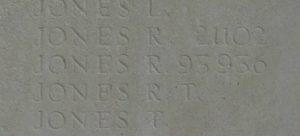
Robert Evan Jones, Private, 20432, Royal Welsh Fusiliers. Robert was the born at Machynlleth in 1895, the son of Evan and Jane Jones. His father was an insurance inspector and the family had moved to Aberdovey by 1899 then by 1901 had moved to Bangor. Robert was educated at Ysgol Friars, Conwy. He came to Llanwnog to work prior to the war and enlisted at Caersws into the 14th Battalion, Royal Welsh Fusiliers. The battalion was raised at Llandudno by the Welsh National Executive Committee, joining 128 Brigade, 43rd (Welsh) Division and trained in North Wales before moving to Winchester in the summer of 1915, where the formation became renumbered 113 Brigade, 38th (Welsh) Division. The Division moved to France on 2 December 1915 and moved to the Nursery Sector near Fleurbaix for trench initiation alongside the Guards Division. On 24 December 1915 the 14th RWF was in the front-line at Laventie when Robert was badly wounded by a British artillery shell which fell short, a fragment of which struck him in the head. He was evacuated to a nearby Field Ambulance but died of his wounds that same day. His brother, Hugh John Jones, in the same battalion, was killed in the same incident, when another shell struck his dugout, causing it to collapse upon him. Robert was 20 years old when he died that day and is buried in La Gorgue Communal Cemetery, France. His brother Hugh is buried in Rue-Du-Bacquerot (13th London) Graveyard, Laventie. Interestingly both men are commemorated on different war memorials around Wales: Robert on the war memorials at Bangor, Ysgol Friars and Llanwnog: Hugh on memorials at Criccieth and Bangor.
William Richard Jones, Lance Corporal, 290193, Royal Welsh Fusiliers. William was the son of Richard and Mary Jones, of The Cross, Caersws. He married Alice Mary Elizabeth Oliver in 1910 and the couple settled at 7, Abbey Terrace, Salop Road, Welshpool, where their two children were born. William had enlisted into the 7th Battalion, Royal Welsh Fusiliers at Welshpool on 3 April 1914. The battalion was a Territorial unit, which mobilised for war at Newtown in August 1914, as part of North Wales Brigade, Welsh Division and moved to Conway until the end of the month, before moving to Northampton. In December the Division moved to Cambridge and then in May 1915 to Bedford, where the Division was numbered and the formation became 158 Brigade, 53rd (Welsh) Division. On 19 July 1915 the entire Division sailed from Devonport for Imbros and on 9 August 1915 landed at Suvla Bay. William did not embark with the original battalion but remained at Bedford with the 2/7th Battalion, Royal Welsh Fusiliers for a while. He finally embarked at Southampton on 11 December 1916 and disembarked in Alexandria, before being posted to the 1/7th Battalion, Royal Welsh Fusiliers. The battalion had been evacuated from Gallipoli in December 1915, moving to Egypt to join the EEF, and helped guard the Suez Canal before taking part in operations to drive the Turks out of the Sinai. The EEF then turned its attention onto driving the Turks out of Palestine, and on 26 March 1917 launched its first offensive against the coastal city of Gaza, which guarded the road to Jerusalem. Initial gains during the day were lost when the assaulting divisions lost touch with each other, and communication broke down when a thick fog cloaked the battlefield. William was killed in action during the heavy fighting for Gaza that day. The 30-year-old is buried in Gaza War Cemetery.
David Davies Lewis, Lance Corporal, G/25885, East Surrey Regiment. David was the son of Owen and Anne Lewis, of Ffynnongedwen, Trefeglwys. He married Elizabeth Minnie Trow in 1914, and the couple had two children over the coming years, Dorothy, born in 1914, and David, born in 1916. David enlisted into the Welsh Horse Yeomanry at Newtown. The regiment had formed in South Wales, and trained at Sophia Gardens, Cardiff, before being transferred to the Montgomeryshire T.F. Association with headquarters at Newtown. The 1/1st Battalion of the regiment joined the 1/1st North Midland Mounted Brigade of 1st Mounted Division in the Diss area, then in September 1915 the battalion dismounted and sailed from Liverpool aboard the RMS Olympic on 25 September 1915, landing at Anzac, Gallipoli on 10 October. David did not embark for Gallipoli with the battalion but remained in Norfolk with the 2/1st Battalion. He was at some time posted to the 12th Battalion, East Surrey Regiment, which was attached to 122 Brigade, 41st Division. The Division had moved to France during May 1916 and began familiarisation with trench warfare in the Ploegsteert sector, remaining there until August 1916, when it moved to the Somme, and fought throughout the Somme offensive, before moving to positions south of Ypres in 1917. Here they took part in the Battle of Messines, before moving further north, where they fought at the Battle of Pilckem, and the Battle of the Menin Road, as part of the Third Battle of Ypres. The Division was selected as one of five British Divisions to be moved to Italy, as part of a reinforcement action taken by the Allies following a disastrous defeat of the Italian Army at Caporetto. By now the Italian front had stabilised, so the Division was hurried back to the Western Front in early March 1918. It then faced the German Spring Offensive of 21 March 1918 and fought in a gallant rear-guard action over the coming days, before being relieved and sent north to Flanders where it held a sector near Ypres that was, for once, relatively quiet. David was killed during a routine spell in the trenches here, at La Clytte, on 14 August 1918. The 29-year-old is buried in La Clytte Military Cemetery, Belgium. His brother, William, had been killed the previous year.
Edward Lewis, Private, 291026, Royal Welsh Fusiliers. Edward was the son of John and Ann Lewis, of Severn Cottage, Caersws. He worked as a railway porter prior to the war. Edward enlisted into the 2/7th Battalion, Royal Welsh Fusiliers at Newtown on 18 March 1915, and was then posted to the 1/7th Battalion, Royal Welsh Fusiliers. The battalion was a Territorial unit, which mobilised for war at Newtown in August 1914, as part of North Wales Brigade, Welsh Division and moved to Conway until the end of the month, before moving to Northampton. In December the Division moved to Cambridge and then in May 1915 to Bedford, where the Division was numbered and the formation became 158 Brigade, 53rd (Welsh) Division. On 19 July 1915 the entire Division sailed from Devonport for Imbros and on 9 August 1915 landed at Suvla Bay. The infantry moved off the beaches into the bush, but due to a lack of maps and no knowledge of the terrain, many of the units became disorientated, and the situation became chaotic. Edward survived the Gallipoli campaign, but after the battalion was evacuated, he returned to England, probably due to sickness. He served at home for the next 18 months, before embarking for France on 19 August 1917, to join the 16th Battalion, Royal Welsh Fusiliers, which was attached to 113 Brigade, 38th (Welsh) Division. Edward was wounded on 15 March 1918 and treated at the 131st Field Ambulance before being sent to the 13th General Hospital at Boulogne and was then sent back to England again. He landed back in France on 16 September 1918, and was posted to the 14th Battalion, Royal Welsh Fusiliers, which was attached to 113 Brigade, 38th (Welsh) Division, joining the battalion a week later, at Heudecourt, where it was rebuilding following heavy losses at Gouzeaucourt. On 4 October the Division crossed the Hindenburg Line at Bony and attacked the Beaurevoir Line at Mortho Wood on 8 October 1918, suffering heavy casualties. Edward was killed in action during the fighting that day. The 20-year-old is buried in Bois-Des-Angles British Cemetery, Crevecoeur-Sur-L’Escaut, France.
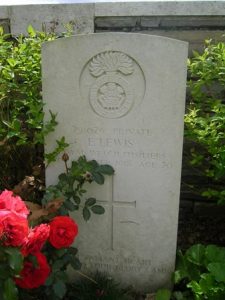
David William Morgan, Lance Sergeant, 21302, Royal Welsh Fusiliers. David was the son of Samuel Walter and Elizabeth Morgan, of Carno Road, Caersws. He enlisted at Caersws into the 14th Battalion, Royal Welsh Fusiliers soon after the outbreak of war. The battalion had been raised at Llandudno by the Welsh National Executive Committee, joining 128 Brigade, 43rd (Welsh) Division and trained in North Wales before moving to Winchester in the summer of 1915, where the formation became renumbered 113 Brigade, 38th (Welsh) Division. The Division moved to France on 2 December 1915 and moved to the Nursery Sector near Fleurbaix for trench initiation alongside the Guards Division. The Division then held a sector of the line near Cuinchy before marching south to the Somme sector in June 1916 to take part in the assault on Mametz Wood. The first attack on the wood was launched on a two-battalion front on 7 July, but failed, and the Divisional Commander, Sir Ivor Philipps, was replaced before the Division attacked again on a two Brigade front on 10 July 1916. David was killed in action during the ferocious fighting within the wood on 10 July 1916. The 23-year-old has no known grave and is commemorated on the Thiepval Memorial, France.
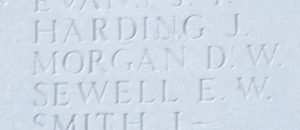
Robert Frederick Nicholas, Sapper, 275900, Royal Engineers. Robert was the son of John and Jane Elizabeth Nicholas, of New House, Caersws. He worked as a cleaner for the Cambrian Railways prior to the war and after enlisting at Newtown into the Royal Engineers, was posted to their Railway Operating Division in France. The unit had been formed in 1915 and was mainly comprised of railway employees who operated both standard and narrow-gauge railways. Robert was posted to the 34th Broad Gauge Operating Company upon his arrival in France. Robert died at one of the General Hospitals in Calais on 24 May 1918. The 24-year-old is buried in Les Baraques Military Cemetery, Sangatte, France.
David Henry Rees, Rifleman, 55624, New Zealand Rifle Brigade. David was born on 18 August 1889, the son of Richard and Mary Rees, of Wyle Cop, Llanwnog. He emigrated to New Zealand in 1910 and found work as a ploughman at Haplau, Salisbury. David enlisted into the New Zealand Rifle Brigade at Timaru on 3 May 1917. He was then posted to the 29th Reinforcements and embarked at Wellington aboard HMNZT 92 for Europe on 15 August 1917, disembarking at Glasgow over two months later before entraining for Bordon Camp in Hampshire. David was drafted to France on 23 October 1917 and joined the 2nd New Zealand Trench Mortar Battery, which was attached to the New Zealand Division, part of the I ANZAC Corps. The Division had forged a reputation as being amongst the best of the British and Empire Divisions to serve during the war and had seen heavy fighting on the Somme in 1916 and at Messines Ridge and Ypres during 1917. David joined the New Zealanders at Ypres, where it was holding the line on Passchendaele Ridge. After wintering at Ypres, the New Zealanders had moved out of the line by March 1918 to rest but following the launching of the German offensive on the Somme front on 21 March, the Division was rushed forwards to hold the line near Hamel, where the Division held off a number of German attacks before launching an offensive to regain the high ground at La Signy farm. By 9 April German attention had switched to the Lys sector, in Flanders, and the New Zealanders remained on the Somme throughout the summer. On 8 August 1918, the last major offensive of the Western Front commenced, with an attack by the Canadian and Australian Corps at Amiens, which broke the German line. On 21 August the Allies launched a general offensive along the Somme front and the ANZAC Corps took part in this great offensive, seeing heavy fighting over the coming days. On 29 August, Bapaume fell to the New Zealanders, while Frémicourt fell the following day. The New Zealand Division continued to advance, with the 2nd Brigade capturing Haplincourt on 3 September, opening up the way to attack the outer defences of the Hindenburg Line. David was killed in action on 27 September 1918. The 29-year-old has no known grave and is commemorated on the Grevillers (New Zealand) Memorial, France. David is also commemorated on the Otipua war memorial in New Zealand.
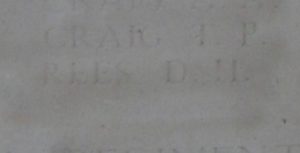
Edward Bennett Savage, Private, 781317, Canadian Machine Gun Corps. Edward was born on 9 March 1890, the son of Richard Savage and Jane Savage (nee Davies), of Penyborfa, Llanwnog. Edward emigrated to Canada as a young man, embarking aboard the SS Megantic at Liverpool on 25 April 1914 and after disembarking at Quebec, moved to Drinkwater, Saskatchewan, where he found work as a farm hand. He enlisted into the 128th Overseas Battalion, Canadian Expeditionary Force at Moose Jaw on 2 December 1915 and embarked for England with the battalion aboard the SS Grampian on 24 August 1916 and upon disembarkation at Liverpool entrained for the Canadian camp at Bramshott. Edward was then attached to the 19th Canadian Machine Gun Company upon his arrival. On 29 January 1918 he was granted leave to marry and married Mary Lilian Davies, of Llandinam, at Hackney on 30 January 1918. Edward was posted to France on 1 March 1918 and was transferred to the 4th Battalion, Canadian Machine Gun Corps, which was attached to the 4th Canadian Division in the Avion Sector. The Division remained in this sector throughout the summer of 1918, until taking part in the combined Australian and Canadian offensive at Villers-Bretonneux on 8 August 1918, which smashed the German lines. The Allies then launched a co-ordinated offensive along the Somme front on 21 August and began driving the Germans back towards the Hindenburg Line. The Canadian Corps then moved north to the Arras sector and joined the great offensive a week later. By 28 September the Canadians had reached the Douai to Cambrai Road where defensive positions were taken up. Edward was badly wounded by German machine-gun fire soon afterwards, suffering multiple wounds to his abdomen, chest, and hand. He was evacuated to the 33rd Casualty Clearing Station at Ficheux, where he died of his wounds on 30 September 1918. The 28-year-old is buried in Bucquoy Road Cemetery, Ficheux, France.
George Arthur Shelton, Gunner, 147062, Royal Field Artillery. George, known as Arthur, was the son of Thomas Shelton, Headmaster, and Sarah Shelton (nee Wade), of The School House, Llanwnog. He served an apprenticeship as a wheelwright at Llanwnog and after completing his apprenticeship enlisted at Welshpool into the Royal Artillery on 5 February 1903. Arthur was then posted to the Depot at Weedon for training, before joining the 114th Battery, Royal Field Artillery. Arthur married Priscilla Lavinia Holton at Amesbury, Wiltshire on 4 November 1908. He left the army on 5 February 1911, joining the Army Reserve and took up a position as a Storekeeper in a brewery, moving his young family to 12, Alexandra Terrace, Colchester. Following the outbreak of war, Arthur was mobilised at Newcastle on 5 August 1915 and was posted to the 1st Division Ammunition Column. The 1st Division formed part of the original BEF, embarking for France soon after the outbreak of war and entrained for the Belgian frontier, near the town of Mons. Arthur then saw action during the Battle of Mons, and in the retreat to the Marne, where the Germans were stopped. The 1st Division then fought at the Battle of the Aisne, before the BEF was moved north to Ypres and saw terrible fighting during the First Battle of Ypres, when the Division helped prevent the fall of the city to the Germans. The 1st Division wintered in Flanders and the following year saw them in action again at the Battle of Aubers, before taking part in the Battle of Loos, and the action at the Hohenzollern redoubt. Arthur served on the Western Front until being discharged from the army upon completion of service on 5 February 1916 and returned to England but re-enlisted into the Royal Field Artillery. He was then posted back to France, joining the 142nd Battery, Royal Field Artillery. Arthur was killed in action at Ypres, during the build-up to the Passchendaele offensive, on 12 July 1917. The 34-year-old is buried in Vlamertinghe New Military Cemetery, Belgium. His youngest son, Richard Edward Shelton, was killed at Monte Cassino on 23 May 1944.
Humphrey Richard Thomas, Corporal, 291007, Royal Welsh Fusiliers. Humphrey was the son of Humphrey and Jane Thomas, of Frankwell Street, Newtown. His father had died by 1904 and his mother went to live in the Union Workhouse at Llanwnog. Humphrey left home and worked as a coalminer at Aberfan prior to the war but had returned to Newtown to enlist into the 7th Battalion, Royal Welsh Fusiliers on 12 March 1915. The battalion was a Territorial unit, which mobilised for war at Newtown in August 1914, as part of North Wales Brigade, Welsh Division and moved to Conway until the end of the month, before moving to Northampton. In December the Division moved to Cambridge and then in May 1915 to Bedford, where the Division was numbered and the formation became 158 Brigade, 53rd (Welsh) Division. On 19 July 1915 the entire Division sailed from Devonport for Imbros and on 9 August 1915 landed at Suvla Bay. The infantry moved off the beaches across the Salt Lake, under shellfire, into the scrub covered Chocolate Hill, but due to a lack of maps and no knowledge of the terrain, many of the units became disorientated, and the situation became chaotic. After the fighting died down, the winter rolled in, and the men first had to endure torrential downpours, which flooded the trenches, before the snow hit, and many men began falling ill in the terrible conditions. Humphrey contracted dysentery due to the terrible conditions on the Peninsula and was evacuated via hospital ship in December before being taken to the 2nd Southern General Hospital at Southmead, Bristol. Upon recovering he was posted to the 3/7th Battalion, Royal Welsh Fusiliers at Oswestry and soon afterwards spent a while at Oswestry Hospital suffering from rheumatic fever. Humphrey embarked for France at Southampton on 20 May 1917 and joined the Infantry Base Depot at Rouen. He was posted to the 15th Battalion, Royal Welsh Fusiliers on 12 June 1917 and joined the battalion at Ypres, where it was attached to 113 Brigade, 38th (Welsh) Division. The Division was preparing to launch an assault against the Pilckem Ridge, as part of the opening offensive of the Third Battle of Ypres, and its infantry brigades were taking turns training behind the lines by the time that Humphrey arrived. The 15th RWF completed its training by 23 July and moved back into the line on the Canal Bank that afternoon. On 27 July 1917 the battalion received reports from the Royal Flying Corps that the Germans had withdrawn, so a strong patrol was sent out to investigate. Unfortunately, the reports proved false, and the patrol came under heavy fire in No Man’s Land, before being forced to withdraw and the Germans opened a terrific artillery bombardment upon the battalions’ trenches in retaliation. Humphrey was killed in action at some time during the day. The 27-year-old has no known grave and is commemorated on the Ypres (Menin Gate) Memorial, Belgium.
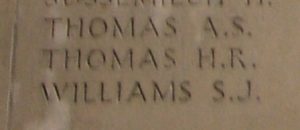
Lewis Thomas, Private, 34154, Oxfordshire and Buckinghamshire Light Infantry. Lewis was the son of John and Sarah Thomas, of Hen Cwm, Llanwnog. He worked as a bootmaker prior to the war. Lewis enlisted into the army and was posted to the 2/4th Battalion, Oxfordshire & Buckinghamshire Light Infantry. The battalion embarked for France on 26 May 1916, attached to 184 Brigade, 61st (South Midland) Division, which took over a section of the line at Fromelles. The first major action in which the Division was engaged turned out to be a disaster. An attack was made by the Division at Fromelles alongside the Australians on 19 July 1916, to divert German attention away from the main Somme offensive, but turned into a disaster, with terrible casualties suffered for no gain. Such was the damage to the Division and its reputation that it was not used again other than for holding trench lines until 1917. In March the 61st Division was one of the Divisions employed in the advance to the Hindenburg Line, following the strategic German withdrawal, and on 17 March, the 61st Division captured Chaulnes and Bapaume. Lewis then went home on leave and married Jane Elizabeth Edwards, of Brynllys, Clatter in the summer of 1917. Upon his return to France, he took part in the Divisions actions during the Third Battle of Ypres. The Division then moved south and was thrown into action following the German counterattack at Cambrai on 30 November, seeing hard fighting during the defence of the La Vacquerie area. During March 1918 the Division was holding the forward zone of defences in the sector northwest of Saint Quentin, near Ham, and suffered terrible casualties as it carried out a gallant rear-guard action over the Somme crossings. The depleted Division was moved to Flanders to rest, but the Germans launched the second phase of their offensive here just weeks later, and the Division was caught up in desperate defensive fighting once more. The Division was then rebuilt before taking part in the great offensive of 21 August 1918 onwards, and took part in the Advance in Flanders, the Final Advance in Artois, the Battle of the Selle, and the Battle of Valenciennes. Lewis survived the war but became ill before demobilisation and was invalided to the 7th Canadian General Hospital at Étaples, where he died of pneumonia on 23 February 1919. The 28-year-old was buried in Étaples Military Cemetery, France.
William Thomas, Private, 55519, Royal Welsh Fusiliers. William was the son of John and Elizabeth Thomas, of Stone House, Caersws. He worked as a farm labourer at Moat Farm, Caersws prior to the war. William enlisted at Welshpool into the Montgomeryshire Yeomanry. William was drafted to France in the autumn of 1916, joining the 17th Battalion, Royal Welsh Fusiliers. The battalion was attached to 115 Brigade, 38th (Welsh) Division and was rebuilding following heavy losses at Mametz Wood in July. The Division was then relieved, taking over a section of the front at Hébuterne before moving to the Ypres Salient, and taking over the Canal Bank sector at Boesinghe. The infantry battalions of the Division then began carrying out the normal pattern of rotation in the trenches, four days in the front, four in support and four in reserve, whilst also working on trench improvement, digging new trenches, and also carrying out regular patrols and trench raids. On 14 February 1917 the 17th RWF relieved the 11th SWB in the front line in the Boesinghe sector to begin a routine spell in the trenches. The Germans opened up a barrage of heavy trench mortar fire upon the line soon afterwards, killing William and one other man. William was 22 years old when he was killed that day and is buried in Ferme Olivier Cemetery, Ieper, Belgium.
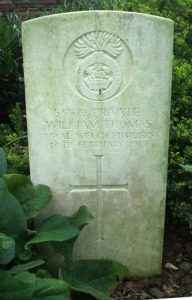
David John Trow, Leading Stoker, K/4783, Royal Navy. David was born on 7 March 1890, the son of Thomas Trow and Emily Trow (nee Gardner), of Hafren Villa, Caersws. He enlisted into the Royal Navy on 3 November 1909 and was posted to HMS Vivid II for training. His first posting was aboard the Drake-class armoured cruiser HMS Leviathan, then he returned to HMS Vivid II for more training. By 1911 David was serving aboard the new Battlecruiser HMS Indefatigable, which was at Devonport, undergoing commissioning before joining the 1st Cruiser Squadron, which in January 1913 was renamed the 1st Battlecruiser Squadron. In December 1913, she transferred to the Mediterranean, where she joined the 2nd Battlecruiser Squadron and following the outbreak of war took part in the pursuit of the German battlecruisers Goeben and Breslau. On 3 November 1914, Winston Churchill ordered the first British attack on the Dardanelles following the commencement of hostilities between Ottoman Turkey and Russia, so Indomitable and Indefatigable, as well as the French pre-dreadnought battleships Suffren and Vérité sailed for the Dardanelles before bombarding the coastal defences on the Gallipoli Peninsula. Indefatigable remained in the Mediterranean until she was relieved by Inflexible on 24 January 1915 and proceeded to Malta for a refit; she then sailed to England on 14 February and joined the 2nd Battle Cruiser Squadron upon her arrival, based at her new mooring in Edinburgh. The 2nd Battle Cruiser Squadron was commanded by Rear Admiral Packenham and was part of Sir David Beatty’s Battlecruiser Fleet. The Fleet put to sea on 31 May 1916 following intelligence reports of the German High Seas Fleet being in the North Sea and steamed at full speed to engage the Germans in the North Sea off Jutland. The two forces met at around 15.30 and Beatty turned his fleet to the south, to gain time before the main Grand Fleet, commanded by Sir John Jellicoe and steaming from Northern Scotland and Scapa Flow, could enter the fight. At 15.48 the Germans opened fire, followed by the British, and twelve minutes later a salvo of German shells struck HMS Indefatigable, igniting her magazines and blowing the doomed ship apart. Only three of the crew of 1,019 survived. David was 27 years old when he was killed in the sudden explosion that day, and is commemorated on the Plymouth Naval Memorial, Devon.
Thomas Watkins, Private, G/3439, Queen’s Own (Royal West Kent Regiment). Thomas was born in 1879, the son of Richard Watkins and Hannah Watkins (nee Richards), of Cwmcwtta, Llanwnog. He worked as a coal miner and resided at Ton Pentre prior to the war. Thomas enlisted at Pentre into the 8th Battalion, Queen’s Own (Royal West Kent Regiment) soon after the outbreak of war. The battalion had formed at Maidstone in September 1914, moving to Shoreham to join 72 Brigade, 24th Division. Thomas landed in France with the battalion on 30 August 1915, and the entire Division moved to reserve positions near Loos. Within weeks of landing, the inexperienced Division was thrown into action at Loos on the second day of the battle, 26 September, and suffered terrible casualties. It was then withdrawn from the line and didn’t see action until the summer of 1916 when it was moved to the Somme. Thomas was transferred to the 1st Battalion, Queen’s Own (Royal West Kent Regiment) at some time after this. The battalion was attached to 13 Brigade, 5th Division. The Division fought throughout the Somme offensive in the summer of 1916, and after suffering heavy casualties, the Division moved to Festubert, where it remained until March 1917. The Division next saw action at the Battle of Arras, fighting at the Battle of Vimy in April 1917, and the attack on La Coulette. On 3 May it fought in the Third Battle of the Scarpe and captured Oppy Wood. On 7 September, the Division was transferred north to take part in the Passchendaele offensive, but in December it was one of the Divisions selected to be sent to Italy, to reinforce the Italian front. The Division was hurried back to France in March 1918 and moved to Flanders during the height of the German Spring offensive. In the middle of August 1918, the Division was pulled from the line to Arcade Camp near Hazebrouck to rest and rebuild, then moved south, back into the line near Gommecourt, to take part in the great Allied offensive, which was launched along the Western Front on 21 August. The Division was in support of the 37th Division during the initial attack, then moved through the Division to take up the offensive. Within days the Division had taken Grevillers and Achiet-le-Petit before reaching Favreuil, skiting north of Bapaume, and by 26 August had taken Beugnatre. The offensive continued towards the Canal du Nord and the Hindenburg Line over the coming weeks. On 18 September 1918 the Allies made a huge attack, known as the Battle of Épehy, just to the south of the 5th Division. During the day, the 1st Queen’s Own, remained in their trenches, enduring a particularly hostile spell of almost incessant artillery fire mixed with gas shell. Thomas was killed in action during the day, most probably because of this artillery-fire. The 39-year-old was originally buried on the battlefield, beside two other comrades, but after the war their graves were exhumed, and the men were re-interred in Gouzeaucourt New British Cemetery, France.
Robert Charles Williams, Rifleman, 241736, The King’s (Liverpool Regiment). Robert was the son of James Thorne Williams and Susannah Elizabeth Williams (nee Davies), of Rhianfa, Caersws. He enlisted into the army at Liverpool and was posted to France early in 1916, joining the 1/6th Battalion, The King’s (Liverpool Regiment), which was attached to 165 Brigade, 55th (West Lancs) Division. Robert probably joined the battalion at Ficheux, where the Division was holding a sector of the front line in the Arras sector, having just relieved a French Division. The Division was relieved by the 11th (Northern) Division on 25 July, and moved south to the Somme, taking up a place in the front line opposite the village of Guillemont. The Division then took part in the Battle of Guillemont and the Battle of Ginchy. There was a short period of rest at Ribemont from 12 to 17 September, and then the Division moved back into the line to join the forces being assembled for the Battle of Flers-Courcelette. On 23 September Robert’s battalion moved forwards along the Flers to Longueval road, coming under shellfire on several occasions, and during the following evening moved into battle positions in front of Flers. At 12.35 on the following day, 25 September 1916, the battalion launched a frontal assault on Flers, together with the remainder of 165 Brigade. The brigade advanced some 800 yards behind a rolling artillery barrage and captured all its objectives. Robert was killed in action during the assault that day. The 20-year-old is buried in A.I.F. Burial Ground, Flers, France.
World War Two, 1939-1945
Hubert Francis Benbow, Sergeant, 1046454, Royal Air Force Volunteer Reserve. Hubert was the son of Martin and Edith Mary Benbow, of 2, Sunnyside, Caersws. He enlisted into the Royal Air Force Volunteer Reserve and trained as a Wireless Operator/ Air Gunner before being posted to 138 Squadron, Royal Air Force. The squadron was reformed in 1941 and became the first squadron of the Royal Air Force Special Duty Service, moving to RAF Tempsford in Bedfordshire to begin operations for the SOE and the SIS, dropping supplies and agents for both clandestine organisations in occupied Europe. On 27 April 1944 Hubert left Tempsford aboard Handley Page Halifax V, Serial LL356, on Operation Osric 59, a mission to drop SOE agents off in Belgium. The aircraft was shot down, possibly by a Flak ship, off the Friesian Islands in the early hours of 28 April 1944 and crashed into the sea, killing all her crew. Hubert was 23 years old when he was killed that morning. He has no known grave and is commemorated on the Runnymede Memorial, Surrey.

Clifford Maldwyn Davies, Lance Bombardier, 886220, Royal Horse Artillery. Clifford was the son of Thomas George Stanley Davies and Elizabeth Maud Davies (nee Williams), of Bronheulwen, Llanwnog. He enlisted into the army soon after the outbreak of war and was posted to the 11th (Honourable Artillery Company) Regiment, Royal Horse Artillery. Clifford married Brenda Eileen Lillian Legerton, of Tolleshunt D’Arcy, Essex, whilst based locally in the winter of 1941. The 11th HAC Regiment embarked for North Africa soon afterwards, in December 1941, to join the expanding 8th Army and soon afterwards became caught up in heavy fighting, following Rommel’s counter-offensive which was launched at the end of January 1941. Clifford was killed during the Battle of Gazala, on 29 May 1942. The 21-year-old is buried in Knightsbridge War Cemetery, Acroma, Libya.
William Sidney Edwards, Private, 4198020, The Parachute Regiment. William was the son of Edward Sidney Edwards and Jane Edwards (nee Jones), of The School House, Llanwnog. He enlisted into the army and was posted to the 10th Battalion, Royal Welch Fusiliers. The battalion was converted to the 6th Battalion, The Parachute Regiment in 1942. The battalion’s first combat action was in 1943, when it participated in an amphibious landing, Operation Slapstick, at the port of Taranto in Italy. The 2nd Parachute Brigade left Bizerta on 8 September 1943, the day before the Italian surrender, and landed unopposed. William did not participate in Operation Slapstick, however. He had died in Tunisia on 31 August 1943, during the preparation for the operation. The 26-year-old is buried in Enfidaville War Cemetery, Tunisia.
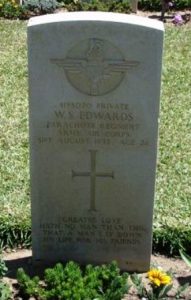
David Bennett Jones, Private, 14639680, South Staffordshire Regiment. David was the son of Daniel Bennett Jones and Hannah Elizabeth Jones, of Rhallt, Caersws. He enlisted into the Royal Welch Fusiliers but was transferred to the 1st Battalion, South Staffordshire Regiment. The battalion was in the Far East when war broke out and following the Japanese invasion of Burma and Malaya became part of Orde Wingate’s Chindit force, as part of the 77th Indian Infantry Brigade. The battalion then took part in Operation Thursday, the second Chindit expedition which began in February 1944 and took part in desperate jungle fighting against the Japanese. David was killed during the fighting for Mogaung on 11 June 1944. The 20-year-old was originally buried in Sahmaw Christian Cemetery, but in July 1954 the war graves within the cemetery were exhumed and he was re-interred into Taukkyan War Cemetery, Myanmar.
George Emlyn Jones, Lance Serjeant, 4079485, South Wales Borderers. George was born at Porthamel Mill, Talgarth, Breconshire on 10 August 1911, the son of Richard and Elizabeth Jones. The family was residing at Three Cocks, Breconshire prior to the war. George was already serving with the Territorial Army prior to the war and served with the 1st Brecknockshire Battalion, South Wales Borderers. The battalion became a Home Guard unit following the outbreak of war and was posted to Liverpool, as part of the Mersey Garrison. George was killed during an air raid, whilst billeted at 107, Rice Lane, Liverpool on 6 September 1940. The remains of the 29-year-old were brought to Llanwnog, and he was buried in St. Gwynog’s Churchyard, Llanwnog.
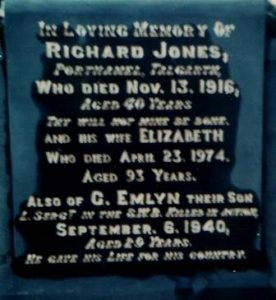
James Robert Jones, Signalman, 2341465, Royal Corps of Signals. James was the son of Thomas Ebenezer Jones and Martha Ann Jones, of Moor Cottage, Caersws. He enlisted into the army and was posted to the 6th Heavy Anti-Aircraft Regiment, Royal Artillery Signals Section, Royal Corps of Signals. James was a signaller, attached to the regiment, which had seen service in France with the BEF in 1940 before being evacuated from Dunkirk. Upon its return to Britain, the regiment moved to Aberystwyth where it re-equipped, before moving to Eastleigh then its batteries were deployed in various locations around the country before seeing serious action again during the Blitz. In September 1941 the regiment was ordered to prepare for embarkation for the Middle East and on 14 November sailed from Liverpool for Iraq, to join the coastal defences of Basra. Meanwhile, the Japanese invaded Burma on 8 December, so the 6th HAA Regiment was diverted to Singapore, disembarking on 13 January 1942, and some of the regiment’s personnel manned guns on the island’s defences. Others were sent to Sumatra to guard two airfields, but by now the regiment was suffering from a lack of equipment. Singapore surrendered on 15 February 1942 and the men of the 6th HAA Regiment stationed there were marched into captivity. Meanwhile the remaining members on Sumatra continued to fight until the island fell on 28 March 1942. James was taken prisoner when Sumatra fell and was among many prisoners taken to Japan to be used as forced labour. He died in Japan on 2 December 1942, aged 27. James has no known grave and is commemorated on the Yokohama Cremation Memorial, Japan.
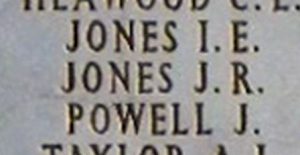
Hubert Llewellyn Morgan, Leading Aircraftman, 1739087, Royal Air Force Volunteer Reserve. Hubert was the son of William Thomas Davies Morgan and Minnie Elizabeth Lewis Morgan (nee Price), of 3, Lower Green, Caersws. He enlisted into the Royal Air Force Volunteer Reserve and after completing his training as an aircraftman was posted to 6298 Servicing Echelon at RAF Tarrant Rushton, in Dorset. Hubert was seriously injured whilst on duty at Tarrant Rushton on 21 January 1945 and was taken by ambulance to the 106th US General Hospital, at Wimborne, where he died of his injuries on the following morning, 22 January 1945. The remains of the 18-year-old were brought home to Llanwnog, and he was buried in St. Gwynog’s Churchyard, Llanwnog.
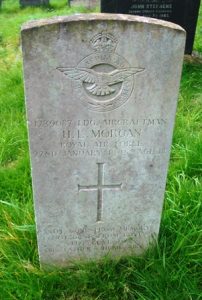
Richard Edward Shelton, Captain, Royal Canadian Artillery. Richard was born on 20 January 1917, the son of George Arthur Shelton and Priscilla Lavinia Shelton (nee Holton). His father was from Llanwnog and was killed on the Western Front in 1917, so his widowed mother emigrated to Canada with Richard and his four elder siblings. Richard lived at 463, Langside Street, Winnipeg prior to the war and he worked as an actor. He enlisted into the 19th Field Battery, Royal Canadian Artillery on 7 September 1939, having already served for six years with the Royal Canadian Horse Artillery, a Militia regiment. Richard was later commissioned as an officer and was posted to the 3rd Field Regiment, Royal Canadian Artillery. The regiment was among the Canadian Forces despatched to Italy and helped capture Sicily during its first major land action of the war in a five-week campaign beginning on 10 July 1943. In September, the Allies invaded the Italian mainland and, although Italy soon surrendered, the occupying Germans fought for every metre of the mountainous terrain. In December, Canadian troops captured the Adriatic port of Ortona following a ferocious house-to-house battle, then took part in the heavy fighting for the Hitler Line that opened the way for the liberation of Rome. Richard was killed during the fighting for the Hitler Line, on 23 May 1944, aged 27. He was originally buried on the battlefield alongside another Canadian soldier, but on 15 February 1945 both men’s graves were exhumed, and they were re-interred in Cassino War Cemetery, Italy. Richard is not commemorated on the Llanwnog war memorial.
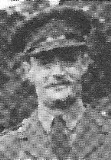
John Cyril Williams, Sergeant, 575332, Royal Air Force. John was the son of John Richard Williams and Amelia Williams, of 3, Stone Houses, Caersws. He enlisted into the Royal Air Force and after completing his training as a Flight Engineer was posted to 35 Squadron, Royal Air Force, which was based at RAF Linton-On-Ouse, in Yorkshire. The squadron was reformed on 5 November 1940 at RAF Linton-on-Ouse as the first Handley Page Halifax squadron. In August 1942 it was one of the five squadrons selected to create the Pathfinder Force and began bombing operations over occupied Europe. On 13 July 1942 John took off from Linton-On-Ouse aboard Handley Page Halifax II, Serial W1154 which formed part of a large force sent to bomb targets in Duisberg. The mission was successfully carried out and the crew returned to Yorkshire in their Halifax but suffered an engine failure on the return leg the following morning, 14 July 1942, diverting to a closer airfield in Kent. As the stricken aircraft crossed the coast five of the crew managed to bale out and survived, but John and Warrant Officer Casey were killed in the resulting crash when the Halifax came down near Canterbury. The remains of the 18-year-old were recovered from the wreckage, and he was brought home for burial in St. Gwynog’s Churchyard, Llanwnog.
